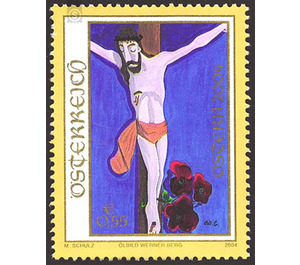painting - Austria / II. Republic of Austria 2004 - 55 Euro Cent
Theme: Art & Culture
| Country | Austria / II. Republic of Austria |
| Issue Date | 2004 |
| Face Value | 55.00 |
| Edition Issued | 600,000 |
| Printing Type | Photogravure |
| Stamp Type | Commemorative |
| Item Type | Stamp |
| Chronological Issue Number | 1813 |
| Chronological Chapter | OOS-OE2 |
| SID | 211592 |
| In 51 Wishlists | |
When we think of "Easter," we probably associate the term automatically with Easter bunnies and Easter eggs. At the same time, we are thinking of the church feast around the crucifixion and resurrection of Jesus Christ. But Easter is also one of the oldest festivals of humanity, with which the resurrection of nature after the long, cold winter, the coming long, bright days and fertility were probably already celebrated in ancient times. The pagan Spring Festival originally got its name from the Near Eastern goddess Astarte (in Ostara or Eostre in the Nordic countries), which stood for East, Dawn, Fertility, and Spring, and among whose sacred animals the Rabbit counted. According to legend, the goddess loved children and gave them colored eggs that had brought their bunny. In any case, eggs were already buried, given away and eaten as a sacrificial custom in Ostarun (the Old High German word for Easter). Like so many other customs, Easter was later Christianised and became the theologically most important feast of Christianity. At the Council of Nicaea in 325, Easter was fixed on the day following the spring equinox after the full moon. After the introduction of the Gregorian calendar, the Western Church agreed on the 1st Sunday after the 1st full moon after the spring equinox (spring begins between 20 and 23 March). The stamp shows a motif by Werner Berg, one of the most important painter and graphic artist of the 20th century. He was born on 11.4.1904 in Elbersfeld and died on 7.9.1981 in Carinthia. He studied in Vienna and Munich, where Emil Nolde promoted him. In 1931, the artist moved to Carinthia on a remote farm, which he lived in until his death in 1981 with his family and managed. The landscape of Carinthia was decisively influenced by clear, bold colors captivating work.


